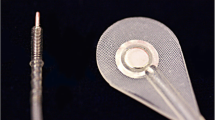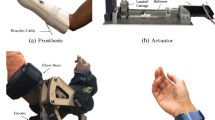Abstract
Electrical nerve stimulation applied to an amputation stump to convey sensory feedback from a myoelectric hand prosthesis inevitably interferes with the prosthesis control system. The intention of this study is to investigate the extent of the interference to allow the implementation of a self-contained myoelectric prosthesis with electrical nerve stimulation feedback. The interference voltage sensed by two types of e.m.g. pick-up electrode units is studied as a function of the distance between the stimulating electrodes and the pick-up electrode units. Results obtained from experiments performed on human subjects andin vitro are supported by results based on electrical field theory. It is concluded that electrical nerve stimulation for prosthesis sensory feedback can be used close enough to myoelectric control systems to be in accordance with the principle of prothesis self-containment.
Similar content being viewed by others
References
Almström, C. (1977) An electronic control system for a prosthetic hand with six degrees of freedom. Technical Report 1: 77, Research Laboratory Medical Electronics, Chalmers University of Technology, Göteborg, Sweden.
Almström, C. (1977) Myoelectric control of multifunctional hand prostheses—Contributions to the pattern recognition approach, to signal acquisition, and to zlinical evaluation. Techinical Report No. 79. School of Electrical Engineering, Chalmers University of Technology, Göteborg, Sweden.
Anani, A. B., Ikeda, K. andKörner, L. M. (1977) Human ability to discriminate various paramters in afferent electrical nerve stimulation with particular reference to prostheses sensory feedback.Med. & Biol. Eng. & Comput.,15, 363–373.
Anani, A. andKörner, L. (1979) An electronic instrument for investigating human response to afferent electrical nerve stimulation. Technical Report 3: 79, Research Laboratory of Medical Electronics, Chalmers University of Technology, Göteborg, Sweden.
Childress, D. S. (1973) Powered limb prostheses: their clinical significance.IEEE Trans.,BME-20, 200–207.
Finley, F. R. andWirta, R. W. (1967) Myocoder-computer study of electro-myographic patterns.Arch. Phys. Med.,48, 598–601.
Herberts, P., Almström, C. andCaine, K. (1978) Clinical application study of multifunctional prosthetic hands.J. Bone Jt Surg.,60-B, 552–560.
Lawrence, P. D. andKadefors, R. (1974) Classification of myoelectric patterns for the control of a prosthesis. InThe control of upper-extremity prostheses and orthoses, Herberts, P., Kadefors, R., Magnusson, R. and Petersén, I. (Eds.) Thomas, Sprinfield, Ill., 190–200.
Lyman, J., Freedy, A. andPrior, R. (1976) Fundamental and applied research related to the design and development of upper limb externally powered prosthesesBulletin of Prosthetics Research, BPR 10-25, 184–194.
Panofsky, W. K. H. andPhillips, M. (1962)Classical electricity and magnetism. Addison-Wesley Publication Company, New York
Plonsey, R. andHeppner, D. B. (1967) Considerations of quasi-stationarity in electrophysiological systems.Bulletin of Mathematical Biophysics,29, 657–664.
Prior, R. E. andLyman, J. (1975) Electrocutaneous feedback for artificial limbs.Bulletin of Prosthetics Research,BPR 10–24, 3–37.
Scott, R. N., Brittain, R. H., Caldwell, R. R., Cameron, A. B. andDunfield, V. A. (1980) Sensory feedback system compatible with myoelectric control.Med. & Biol. Eng. & Comput.,18, 65–69.
Shannon, G. F. (1976) A comparison of alternative means of providing sensory feedback on upper limb prostheses.Med. & Biol. Eng.,14, 289–294.
Shannon, G. F. (1979) A myoelectrically-controlled prosthesis with sensory feedback.Med. & Biol. Eng. & Comput.,17, 73–80.
Solomonow, M. andLyman, J. (1977) Artificial sensory communications via tactile sense. Space and frequency optimal displays.Ann. Biomed. Eng.,5, 273–286.
Szeto, A. Y. J., Prior, R. E., Duncan, J. S. andLyman, J. (1976) Comparison of electrocutaneous codes for sensory feedback.Proc. of the San Diego Biomedical Symposium,15, 109–114.
Szeto, A. Y. J. Prior, R. E. andLyman, J. (1977) Electrocutaneous pulse rate and pulse width psychometric function.Proc. of 1977 ISPOWorld Congress, New York, p. 92.
Author information
Authors and Affiliations
Rights and permissions
About this article
Cite this article
Almström, C., Anani, A., Herberts, P. et al. Electrical stimulation and myoelectric control. A theoretical and applied study relevant to prosthesis sensory feedback. Med. Biol. Eng. Comput. 19, 645–653 (1981). https://doi.org/10.1007/BF02442780
Received:
Revised:
Issue Date:
DOI: https://doi.org/10.1007/BF02442780




